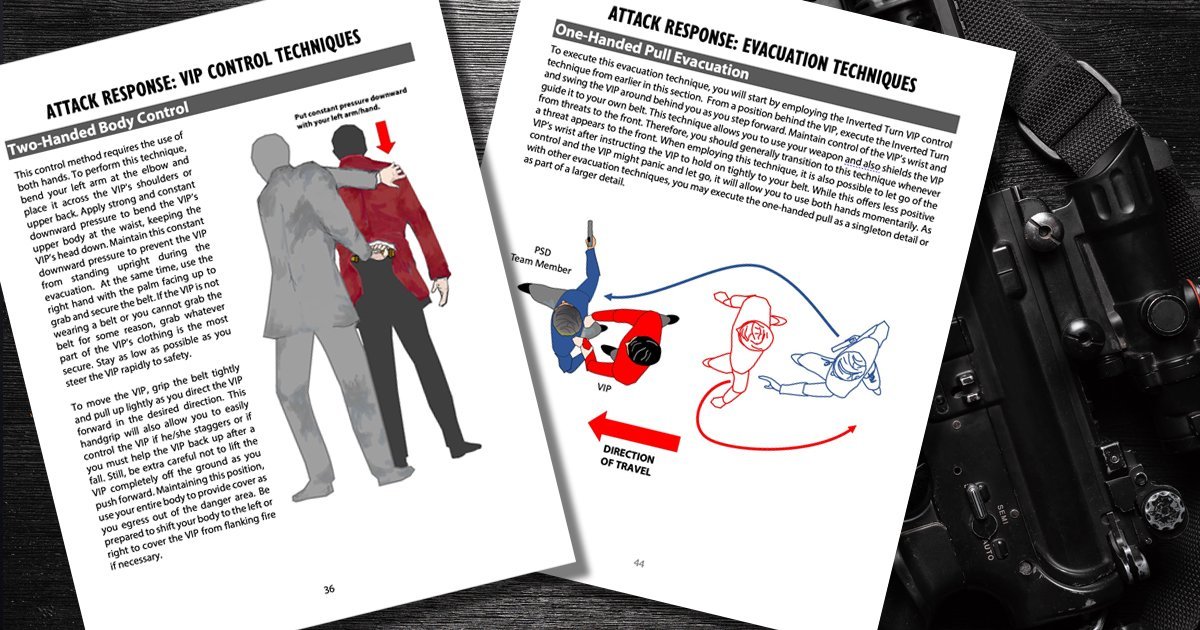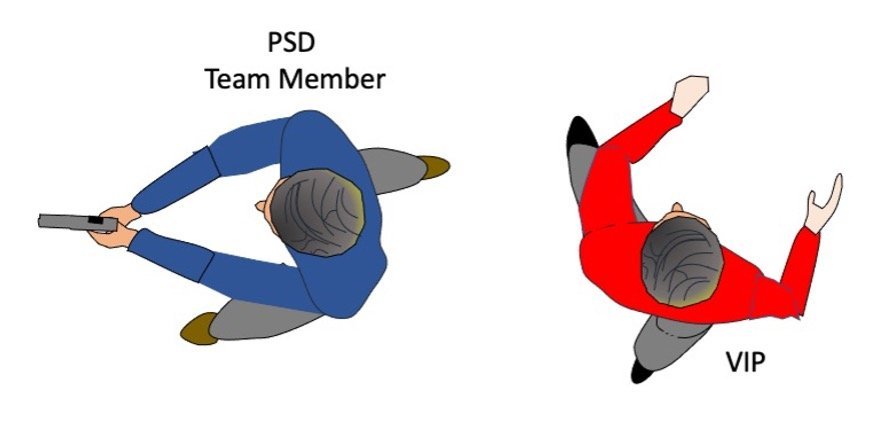Close Protection VIP Body Control and Evacuation Techniques
This article is adapted from our new Escort Detail Venue VIP Protection book. The article offers a few examples of techniques for physically controlling and evacuating the VIP in an emergency situation. We welcome your reactions, comments and ideas on our Facebook page and if you like the article, click below to check out the book on Amazon.
Venue Close Protection: VIP Body Control and Evacuation Techniques
When an attack takes place you will generally not continue moving in your standard walking formation. Rather you will either form a close or contact protective ring and grab hold of the VIP to physically control the VIP’s movement. This section offers a number techniques for grabbing and physically controlling the VIP in an emergency situation.
Two Handed Body Control Technique
This control method requires the use of both hands. To perform this technique, bend your left arm at the elbow and place it across the VIP’s shoulders or upper back. Apply strong and constant downward pressure to bend the VIP’s upper body at the waist, keeping the VIP’s head down. Maintain this constant downward pressure to prevent the VIP from standing upright during the evacuation. At the same time, use the right hand with the palm facing up to grab and secure the belt. If the VIP is not wearing a belt or you cannot grab the belt for some reason, grab whatever part of the VIP’s clothing is the most secure. Stay as low as possible as you steer the VIP rapidly to safety.
To move the VIP, grip the belt tightly and pull up lightly as you direct the VIP forward in the desired direction. This handgrip will also allow you to easily control the VIP if he/she staggers or if you must help the VIP back up after a fall. Still, be extra careful not to lift the VIP completely off the ground as you push forward. Maintaining this position, use your entire body to provide cover as you egress out of the danger area. Be prepared to shift your body to the left or right to cover the VIP from flanking fire if necessary.
Two-Handed Push Evacuation Technique
Like all single person techniques, you may execute this technique as a singleton detail or as part of a larger protective detail. Controlling the VIP with two hands from behind gives you the best control over the VIP but prevents you from drawing your weapon. This technique can also expose the VIP to threats from the front. Therefore, it is best to use this technique when helping the VIP to move quickly away from a threat that is to the rear of the formation. It is also safer to use this technique when part of a larger detail since other detail members can draw weapons if needed to deal with threats. To control the VIP, use the Two-Handed Body Control technique explained earlier in this article. Use one arm to secure and push downward on the VIP’s upper shoulder area while you grab and secure the belt or waist area with the other hand. The palm of the hand securing the waistline should be facing up.
Inverted Turn Body Control Technique
This technique allows you to move from a position behind the VIP to a position in front of the VIP. There are any number of reasons you might choose to do this. A threat might appear to the front and you will need to place yourself between the threat and the VIP. Or, you might need to move in front to quickly guide the VIP to safety. This method requires you to use only one hand, which means you can have your weapon drawn in the other hand if needed. If your weapon is not already drawn, it is also possible to draw your weapon with your strong hand while you simultaneously perform this technique with your weak hand. To execute this technique, invert your left/weak hand with the thumb pointed down and slide it forward on the inside of the VIP’s elbow. Firmly pull your arm outward and around in an arc to swing the VIP to the left as you step forward in front of the VIP. At this point you can either keep distance from the VIP to address a threat, or you can maintain physical contact with the VIP as we will explain in the next section.
One-Handed Pull Evacuation Technique
As just stated, after conducting the Inverted Turn technique you can maintain control of the VIP using the following method. From a position behind the VIP, execute the Inverted Turn and swing the VIP around behind you as you step forward. Keep hold of the VIP’s elbow after swinging him/her around. Then slide your hand down to the VIP’s wrist and direct it toward your middle of your back towards your belt. Instruct the VIP to grab hold. You can now tow the VIP around behind you while keeping your weapon drawn with the opposite hand. This technique allows you to use your weapon and also shields the VIP from threats to the front. Therefore, you should generally transition to this technique whenever a threat appears to the front. When employing this technique, it is also possible to let go of the VIP’s wrist after instructing the VIP to hold on tightly to your belt. While this offers less positive control and the VIP might panic and let go, it will allow you to use both hands momentarily.
Brief Separation
In some cases, the OIC or PSD member controlling the VIP might need to let go of the VIP and separate briefly in order to deal with a threat or engage targets. The detail member might also need to break away to quickly scout ahead for danger, clear around a corner or check that a room is safe before entering. While brief separation might sometimes be necessary, it places the VIP at increased risk. Ideally, the VIP should not be left alone for long. The brief separation technique becomes less necessary with a larger detail since the OIC can remain with the VIP while other detail members separate to deal with threats.
Combination of Evacuation Techniques
When conducting an evacuation, it is likely that you will need to combine a number of the techniques just described as you react to the situation. For example, you might begin with the two-handed push technique as you move the VIP quickly away from a threat. However, before entering the safe haven, you will transition to the one-handed pull to allow you to be the first into the room. Once in the safe haven, you might need to separate from the VIP briefly to engage targets, check the room for threats, close doors or provide rear security. When it is time to move, you will need to take physical control of the VIP once again. These principles apply to both a singleton detail and a larger detail.
We hope you found the short article useful and once again we welcome your reactions, comments or suggestions on our Facebook page where we frequently hold constructive discussions on tactics with people from various tactical backgrounds and experience levels. Also, click below if you would like to check out the full book on Amazon.







